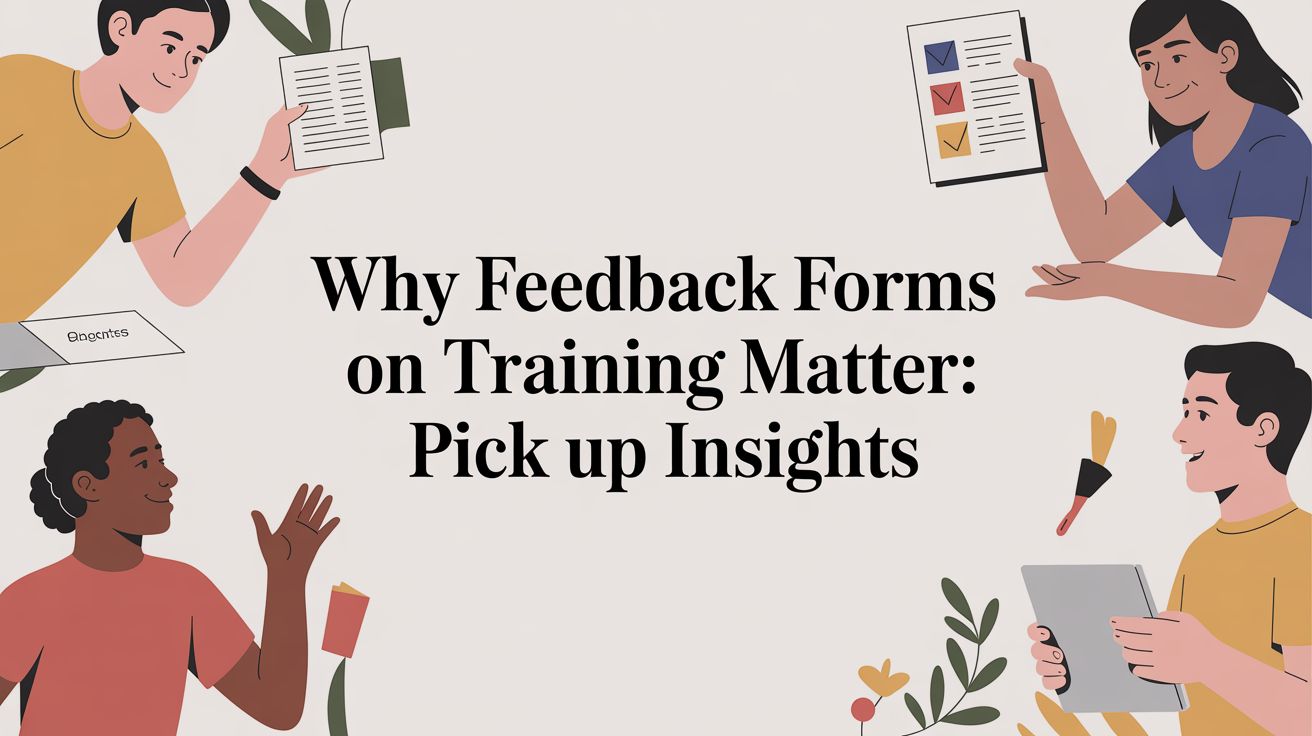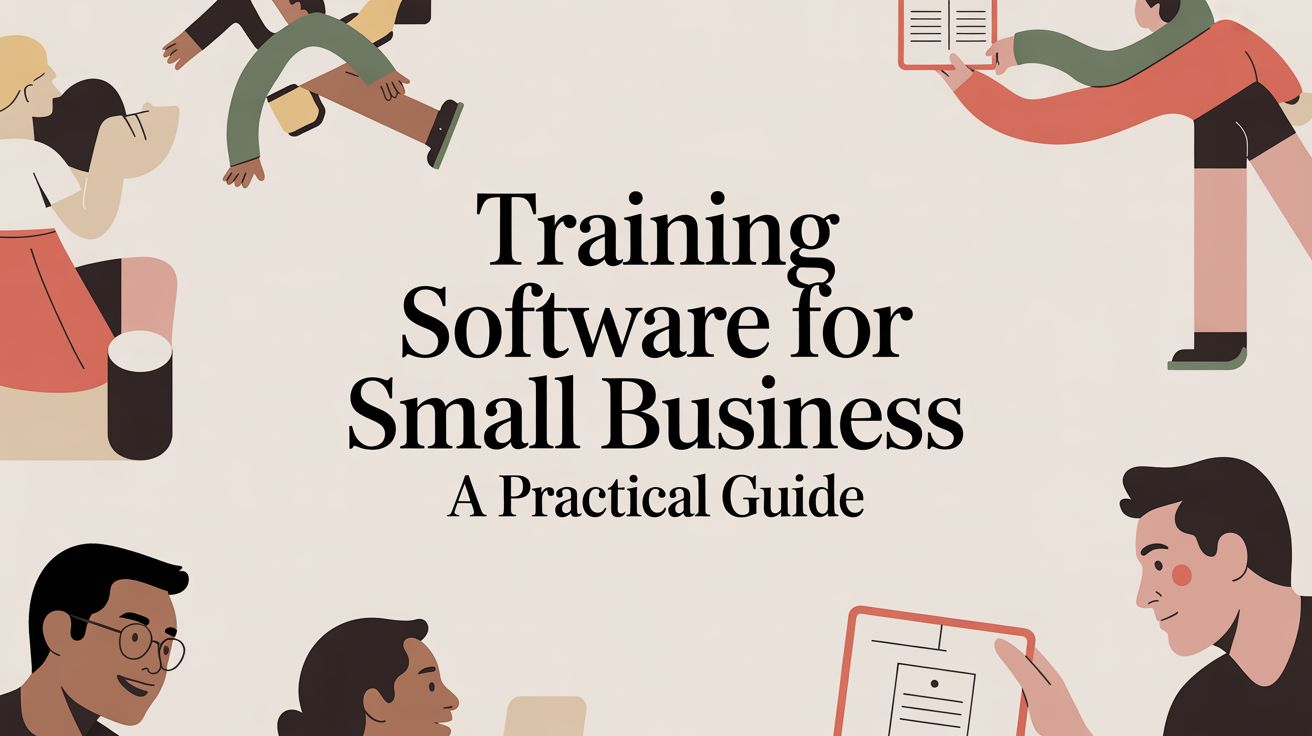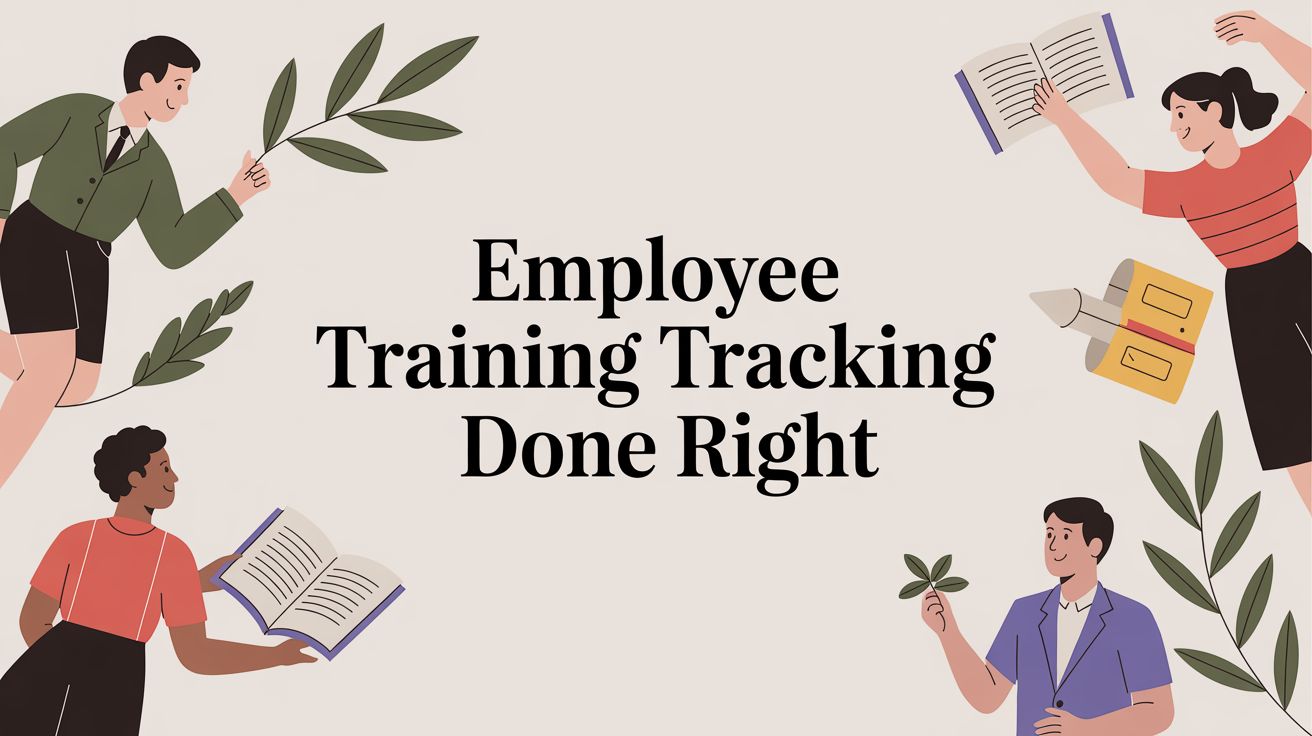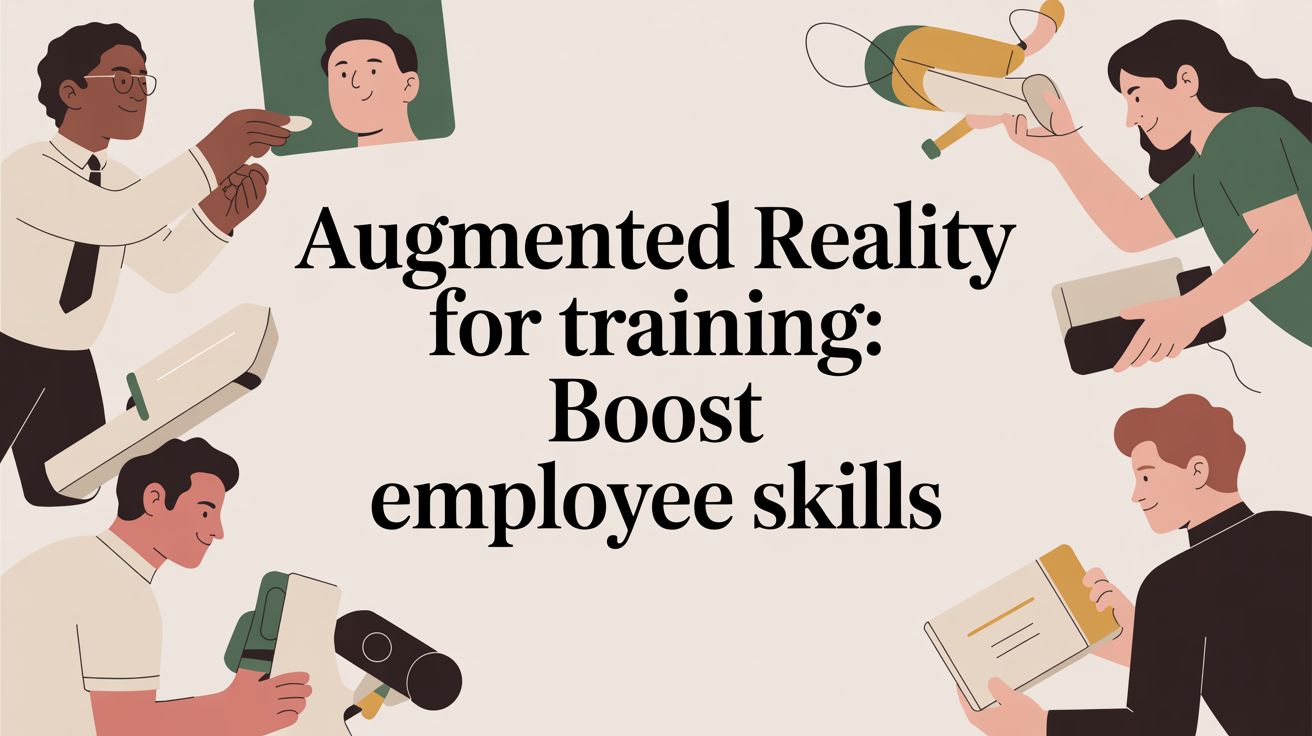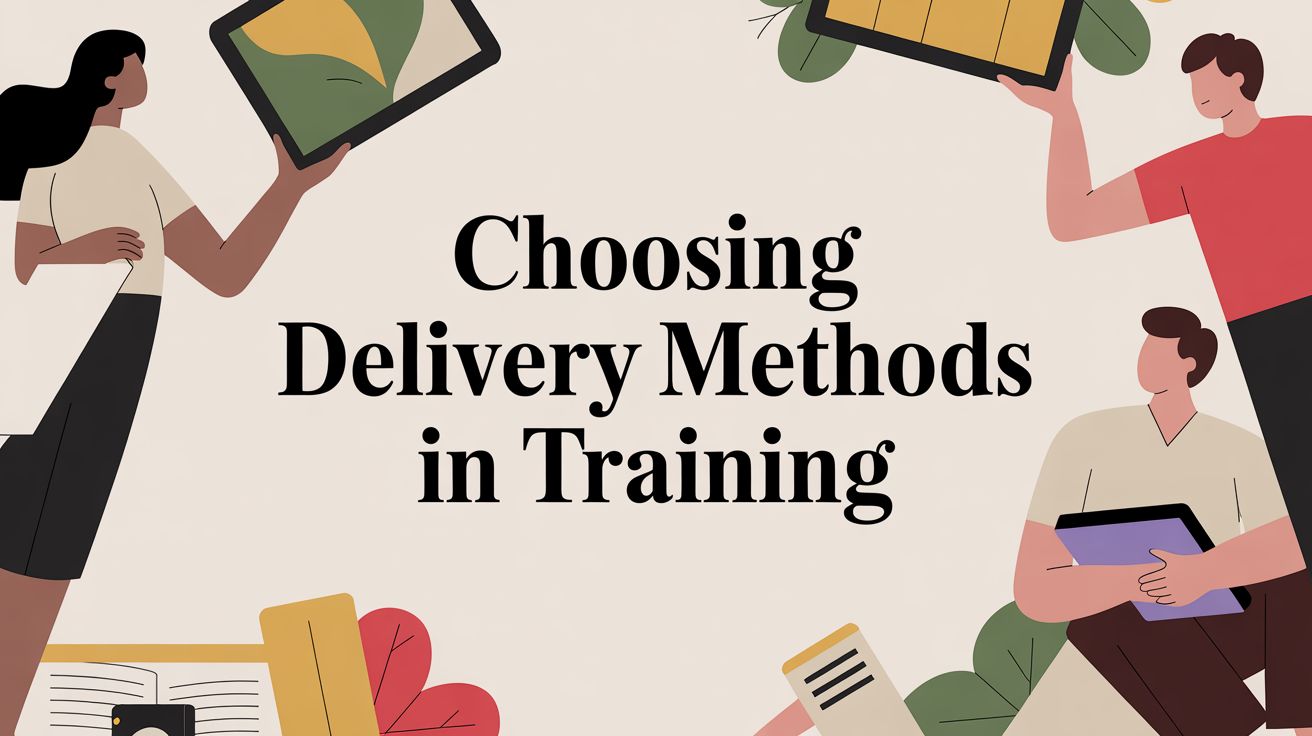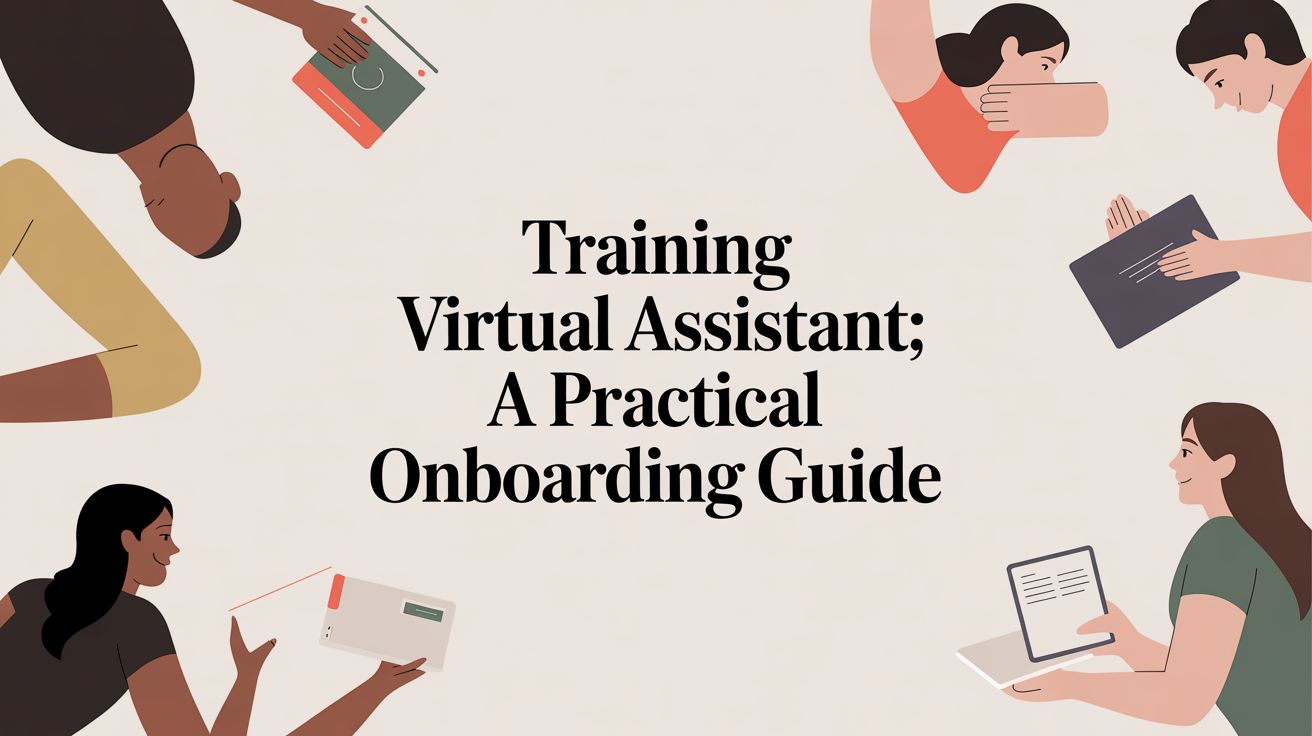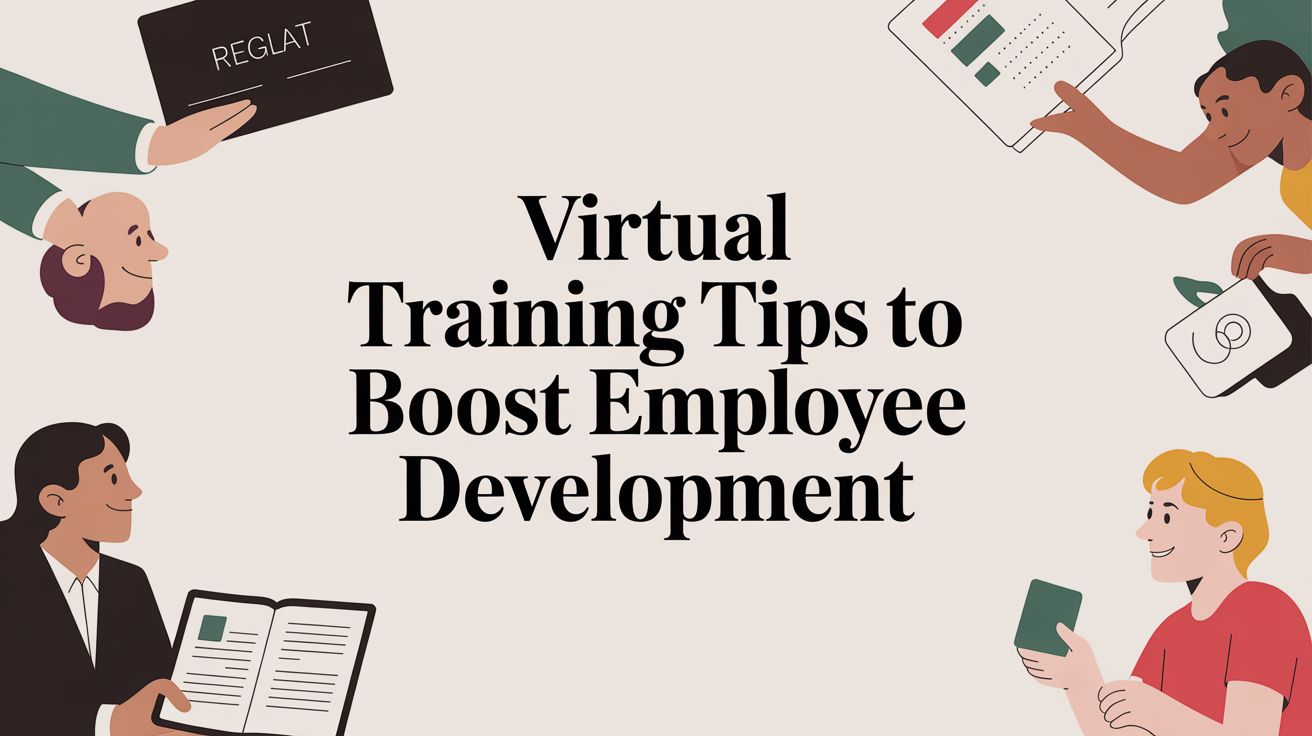How to Measure Training Effectiveness: Key ROI Metrics
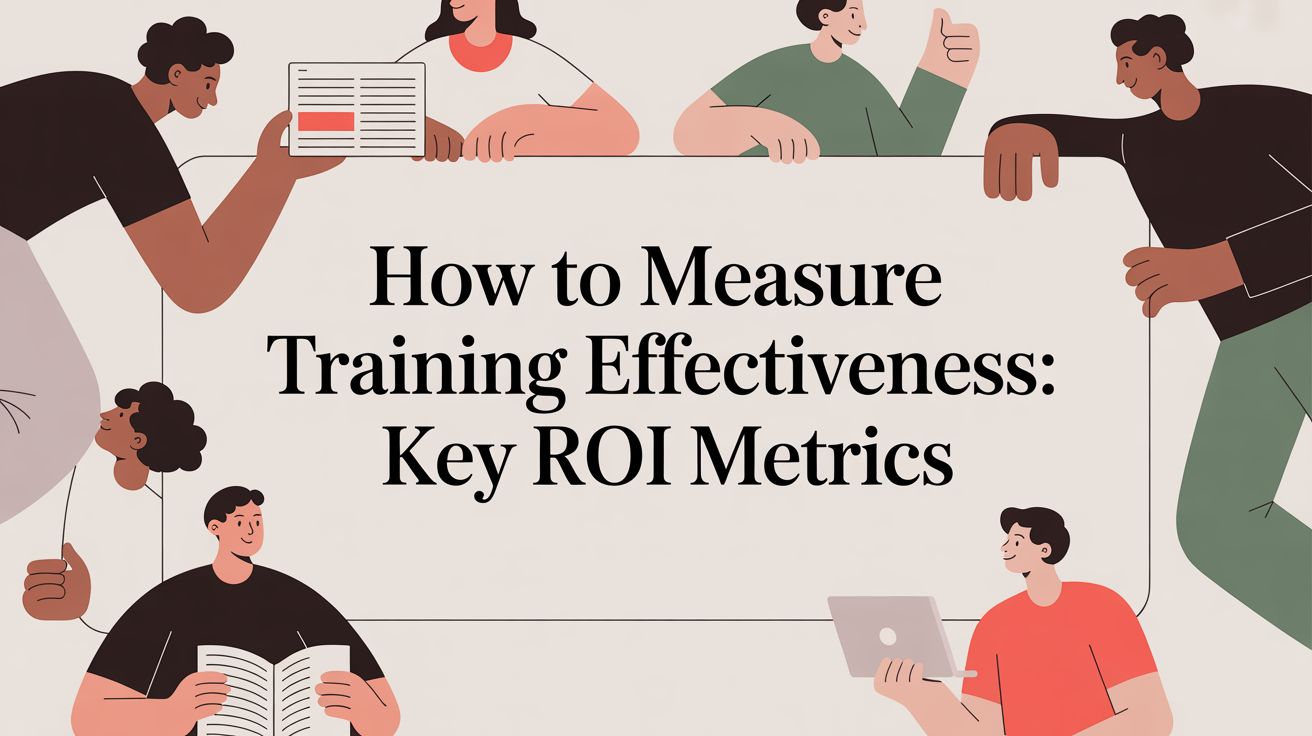
For too long, we've measured training effectiveness with a simple, yet deeply flawed, tool: the post-session survey. We've all seen them. Did you like the instructor? Was the room comfortable? Was the coffee hot? We call them "smile sheets" for a reason—they measure satisfaction, not skill.
But here’s the hard truth I’ve learned over the years: a happy employee isn’t necessarily a more capable one. Real training effectiveness isn't about smiles; it's about whether the learning translates into better performance on the job and, ultimately, moves the needle on business goals. It’s about connecting the dots between the training room and the bottom line.
Moving Beyond Smile Sheets to Real Metrics
Relying on feel-good feedback creates a dangerous blind spot. Companies invest billions in employee development, but when it comes time to justify that spending, many L&D leaders can only point to attendance numbers and satisfaction scores. That's not a story about impact; it's a story about activity. It tells you who showed up, not what changed because they did.
The Problem with Outdated Metrics
So why do these old-school metrics fall so short? Because they’re completely disconnected from actual job performance. An employee can give a workshop a perfect five-star rating and then go back to their desk and not change a single thing about how they work.
This disconnect happens for a few common reasons:
- The Content Misses the Mark: The training might cover interesting theories but doesn't address the real-world challenges the employee faces every day.
- The Forgetting Curve is Brutal: Without immediate reinforcement, people forget up to 90% of what they learn within a month, according to research on learning retention. The knowledge simply evaporates.
- There's No Follow-Through: When measurement ends the moment the session does, there's no accountability for applying the new skills.
This approach treats training as a one-and-done event. It's like judging a chef's cooking by how happy the diners look, without ever tasting the food. The real question isn't, "Did you enjoy the session?" It's, "What can you do now that you couldn't do before?"
Pro Tip: Change the conversation with leadership. Stop reporting on activity (e.g., "we trained 50 managers") and start reporting on outcomes ("after the training, our new managers saw a 20% improvement in team retention"). This reframes training from a cost into a strategic investment.
The Shift from Outdated Metrics to Impactful Measures
To truly see what's working, we have to evolve how we think about measurement. It's not about abandoning feedback entirely, but about layering it with data that speaks to business leaders in their own language.
| Outdated Metric (What We Used to Track) | Modern Metric (What We Should Track Now) |
|---|---|
| Attendance Rates: How many people showed up? | Skill Application: Are people using the new skills on the job? |
| "Smile Sheet" Scores: Did they like the training? | Behavioral Change: Have specific on-the-job behaviors improved? |
| Completion Certificates: Who finished the course? | Performance KPIs: Did sales, productivity, or quality metrics improve? |
| Hours of Training Delivered: How busy was the L&D team? | Business Impact: Did we reduce costs, increase revenue, or lower turnover? |
This table isn't just a list of metrics; it represents a fundamental mind-set shift from tracking activity to measuring tangible impact. It's about proving value, not just presence.
Making the Shift to Meaningful Measurement
To understand how to measure training effectiveness, you have to start with the end in mind. Before you even think about content or instructors, ask the tough questions.
What business problem are we actually trying to solve here? Is it high customer churn? A sluggish sales pipeline? Too many safety incidents on the factory floor? When you define the desired business outcome first, you can design training that is laser-focused on solving that specific problem.
And for instructor-led sessions, making the experience engaging is critical for skill transfer. Our guide on creating more interactive training has some great, practical ideas for this.
Ultimately, your goal is to draw a straight line from the learning experience to the company's financial health. When you can confidently walk into a boardroom and show that your leadership program led to a 15% decrease in team turnover, you’re no longer just justifying a budget. You’re proving your department is a vital engine for growth.
A Practical Framework for Measuring Real-World Impact
So, how do we get past the happy sheets and actually figure out if our training is making a difference? You need a solid, repeatable system that connects what happens in the training room to what happens on the job.
While there are a few models out there, one has been the gold standard for decades for a reason. It just works.
It's called the Kirkpatrick Four-Level Training Evaluation Model. Don't let the formal name fool you; this thing is incredibly practical. Developed way back in the 1950s by Donald Kirkpatrick, it breaks down evaluation into four simple, logical levels: Reaction, Learning, Behavior, and Results. Each level tells a bigger piece of the story, giving you a complete picture of your training's true impact.
Let's ditch the theory and make this real. Imagine we're rolling out a new leadership program for a group of first-time managers. Here’s how we’d use the model.
Level 1: Gauging Immediate Reactions
Right at the start, you need to capture the immediate vibe. This is Level 1: Reaction. It’s more than just asking if they liked it. We need to know if they found it valuable.
Forget generic questions like, "Did you enjoy the session?" They don't give you anything actionable. Instead, get specific:
- "On a scale of 1-10, how relevant was the content to the challenges you face every day as a manager?"
- "Which specific module felt the most practical, and why?"
- "How confident are you right now about applying what you just learned?"
See the difference? We’re digging for perceived value, not just satisfaction. For live training, getting this feedback instantly is key. A good training management system can pop a quick survey onto their screens the moment a session ends, catching them while the experience is still top of mind.
Level 2: Proving Knowledge and Skills Were Gained
Next up is Level 2: Learning. This is where we get our proof. Did they actually learn what we set out to teach them? This is how you separate opinion from evidence.
The classic, and most effective, way to do this is with pre- and post-training assessments. Before our leadership program kicks off, we might send the managers a short quiz on handling difficult conversations or a quick scenario test about prioritizing team tasks. After the program, we send them a similar one.
That gap between the before and after scores is your hard data. A 25% average jump in post-test scores is a concrete stat you can take to leadership. It proves your program did more than just get people out of the office for a day.
Level 3: Observing On-the-Job Behavior Change
This is where the rubber really meets the road. Level 3: Behavior asks the million-dollar question: Are people actually using their new skills back at their desks? It’s one thing to know something; it’s another thing entirely to do it.
This part takes time. You’ll be looking for evidence weeks, or even a few months, after the training wraps up. Some great ways to gather this intel include:
- 360-Degree Feedback: Ask the new manager's direct reports, peers, and their own boss if they've noticed a change in how they communicate or delegate.
- Direct Observation: Have a senior leader or HR partner sit in on a team meeting to see firsthand how the new manager guides the conversation.
- Structured Check-ins: Schedule time to ask the managers for specific examples of how they’ve applied a new skill, like a feedback model from the training.
My favorite pro tip: Give managers a simple "application checklist" after the training. Prompt them to try specific skills, like "Hold a one-on-one using the new coaching framework," and jot down notes on how it went. This not only reinforces the learning but also gives you fantastic qualitative data.
Level 4: Connecting the Dots to Business Results
Finally, we arrive at Level 4: Results. This is the holy grail. It’s where you tie the behavior changes you saw in Level 3 directly to the business goals you defined from the very beginning.
For our new manager program, let's say a key business goal was to reduce team turnover. If, six months after the training, you can show that teams run by your newly trained managers have a 10% lower attrition rate than the company average, you’ve just made a powerful business case for your program.
Other Level 4 metrics could be things like:
- An increase in team productivity or sales figures.
- Higher scores on the annual employee engagement survey.
- A drop in customer complaints for client-facing teams.
Of course, to measure training impact effectively, you have to know what kind of training you're dealing with in the first place. Understanding the nuances between different types of training sessions helps you tailor your measurement strategy perfectly. This entire framework shifts measurement from an afterthought to a core part of the process, helping you tell a compelling story about the value you deliver.
Connecting Training Spend to Business Results
While the Kirkpatrick Model tells a compelling story about behavior change, there's one question it doesn't directly answer—the one your CFO is definitely asking: "What's the return on our investment?" To justify budgets and prove your training's value in the language of the C-suite, you have to connect the dots directly to the bottom line.
This is exactly where the Phillips ROI Model shines. Developed by Jack J. Phillips, it brilliantly builds on Kirkpatrick’s work by adding a fifth and final level: translating those business results into a clear financial figure. It’s how you prove your training isn’t just an expense, but a profitable investment.
Introducing the Fifth Level: Return on Investment
The Phillips ROI Model is all about putting a dollar sign on your outcomes. Instead of stopping at behavioral or operational changes, it calculates the hard monetary benefits of your training relative to its cost. In fact, organizations that adopt this kind of ROI-focused thinking often find their training programs have up to 20% greater alignment with core business objectives.
Calculating ROI might sound like a job for the finance team, but the logic is pretty straightforward. You're just moving from abstract benefits to concrete numbers that leadership can't ignore.
Isolating the Impact of Your Training
First things first, you have to prove it was your training that caused the positive results. Was it the new sales program that boosted revenue, or was it a new marketing campaign that launched at the same time? Getting this right is critical for your credibility.
Here are a few practical ways to isolate your program's impact:
- Use a Control Group: This is the gold standard. Compare the performance of a group that went through the training against a similar group that didn't. The difference in their results is a powerful indicator of your program's true effect.
- Trend Line Analysis: Take a look at performance data before and after the training. A sharp, sustained jump in performance right after your program wraps up helps build a strong case.
- Ask the Experts (Participants and Managers): Survey participants and their managers, asking them to estimate what percentage of their performance improvement they believe is a direct result of the training. Averaging these estimates gives you a reasonable, defensible figure.
Pro Tip: Always be conservative with your numbers. If managers estimate the training was responsible for 40% of the performance uplift, use 40%. It’s far better to slightly understate your ROI than to have your entire analysis dismissed for being overly optimistic.
Converting Data to Monetary Value
Once you’ve isolated the impact, it’s time to assign a dollar value to it. This is where you translate operational gains into the language of finance. It's a similar mindset to calculating return on investment for initiatives in other parts of the business.
Let’s walk through a real-world scenario. A logistics company rolls out a new safety compliance program for its warehouse team to cut down on workplace accidents.
Here’s how you could convert those results into cash:
- Reduced Incident Costs: You discover that reportable safety incidents dropped by 30% post-training. By calculating the average cost of an incident (think medical bills, lost work time, potential fines), you can attach a direct cost saving. If each incident costs the company $5,000 and you prevented 10 of them, you just saved $50,000.
- Lower Insurance Premiums: A better safety record often means lower workers' comp insurance premiums. If your annual premium dropped by $20,000 and you can tie it to the improved safety metrics, that’s another tangible win.
- Increased Productivity: Fewer accidents mean less downtime. You can calculate the value of all the productive hours that were saved instead of being lost to incidents.
This process is even more powerful when you link these outcomes to specific employee skills, which is a core idea behind https://coursebricks.io/blog/competency-based-training.
The Final ROI Calculation
With all your data collected, the final math is simple. The formula looks like this:
(Net Program Benefits / Program Costs) x 100 = ROI %
First, find your Net Program Benefits by subtracting the total program cost from the total monetary benefits. Then, just divide that number by the costs and multiply by 100 to get your ROI percentage.
Let's finish our logistics company example:
- Total Monetary Benefits: $50,000 (incident savings) + $20,000 (insurance savings) = $70,000
- Total Program Costs: $25,000 (for the instructor, materials, and employee time away from the floor)
- Net Benefits: $70,000 - $25,000 = $45,000
ROI Calculation: ($45,000 / $25,000) x 100 = 180%
An ROI of 180% is a powerful number. It means that for every single dollar the company invested in safety training, it got $1.80 back. Now that’s a statement that proves the undeniable value of your work.
Navigating Common Measurement Hurdles
Knowing the models is one thing. Putting them to work in the real world, with all its messiness, is a completely different beast. The road to proving your training actually worked is often full of obstacles that can trip up even the best-laid plans.
Let's get real. One of the biggest challenges is simply isolating the impact of your training. Imagine you've just launched a fantastic new sales program. The next quarter, sales jump by 15%. A clear win, right? Not so fast. What if the marketing team also launched a killer new ad campaign and the product team released a long-awaited feature that same quarter? Suddenly, it’s a lot harder to draw a straight line from your training to that sales bump.
Proving Training Was the Difference Maker
To build a credible case, you have to untangle your training's impact from all the other things happening in the business. Don't worry, you don't need a team of data scientists to do this. A few practical approaches can make all the difference.
A great way to do this is with a control group. Before you roll out the program to everyone, find two similar teams. One team gets the training (your "test group"), and the other (your "control group") doesn't. Then, you watch their performance metrics for a few months. Any significant gap that opens up between them gives you a much stronger argument that the training was the key variable.
You should also lean into qualitative data. Sit down for structured interviews with the managers of the employees who went through the training. Ask them direct questions: "What specific behaviors have you seen change since the training?" or "Can you give me an example of someone using a new skill from the program to handle a situation?" These stories add a ton of color and context to your hard numbers.
My Two Cents: Don't chase perfection here. You'll probably never be able to prove your training's impact with 100% certainty, and that's okay. The goal is to build a compelling, evidence-based story that shows a strong, logical link between what people learned and how the business benefited.
The Challenge of Proving Financial Return
Even when you can show clear behavior change, connecting that to a dollar amount can feel like a huge leap. This isn't just a feeling; it's a major issue across the industry. Data shows that only about 33% of organizations in North America even try to measure the financial return on investment (ROI) for their training. In fact, 46% of L&D pros say that demonstrating ROI is one of the toughest parts of their job.
The difficulty usually stems from not having a clear way to translate things like higher productivity or better safety records into actual money. The trick is to partner with department heads before the training even starts. Agree on the business metrics that matter most and exactly how you'll track them. Getting this buy-in upfront means everyone is on the same page when it’s time to look at the results.
Overcoming Low Learner Engagement
Another common roadblock is simply getting people to engage with your measurement tools. You can create the world's most insightful post-training survey, but it's worthless if no one fills it out. Low response rates can seriously skew your data, leaving you with a fuzzy, incomplete picture.
The fix is to make giving feedback as easy and immediate as possible. This is especially true for live sessions. Think about instructor-led training—instead of emailing a survey link a day later when it’s already buried in someone’s inbox, capture feedback right then and there. A good training management system can automatically prompt participants for their thoughts the moment a session ends, when the experience is still fresh in their minds.
Ultimately, getting past these hurdles is about shifting your mindset. You have to think like a detective—gathering clues from different sources, building a logical case, and presenting your findings with confidence. If you anticipate these challenges and have a plan to tackle them, you can turn these common roadblocks into a solid foundation for your measurement strategy.
Using Technology to Simplify Measurement
Let's be honest. Trying to manually track surveys, quiz scores, and performance data for live training is a logistical nightmare. You end up juggling spreadsheets for attendance, blasting out survey links via email, and then desperately trying to connect that mess to actual performance reviews.
This administrative headache is the number one reason robust measurement often gets pushed to the back burner in favor of simpler, less insightful methods. It’s just too much work.
This is where the right technology completely changes the game. A dedicated Training Management System (TMS) isn't just another tool; it's a way to cut through the administrative friction so you can focus on analyzing what works, not just managing logistics.
Automating Data Collection Across Kirkpatrick's Levels
A good TMS becomes the central hub for your instructor-led and hybrid training programs. Instead of just being a place to store records, it actively automates the critical first steps of the Kirkpatrick Model, ensuring you gather consistent and timely data without chasing anyone down.
Here’s how it works in practice:
- Level 1 (Reaction): The system can automatically trigger a satisfaction survey the minute a live session ends. This captures immediate, honest feedback while it’s still fresh, which dramatically boosts response rates compared to a follow-up email a week later.
- Level 2 (Learning): Pre- and post-training quizzes can be scheduled and sent out automatically. The TMS tracks who has completed them and instantly calculates the scores, giving you a clear, quantifiable look at knowledge gain.
- Level 3 (Behavior): While a TMS can't physically watch people work, it can schedule and send automated follow-up surveys to managers 30, 60, or 90 days after the training. These prompts can ask for structured feedback on how an employee is applying specific new skills.
The right technology turns measurement from a series of disjointed manual tasks into a smooth, automated workflow. That consistency is everything when it comes to reliable evaluation.
A TMS like Coursebricks is built specifically for the chaos of managing live, hybrid, and face-to-face training events. It’s a different beast than a Learning Management System (LMS), which is typically designed for self-paced eLearning. If you're curious about the differences, our guide on the best LMS for corporate training breaks it all down.
Centralizing Data for Deeper Insights
Maybe the biggest win of using a TMS is creating a single source of truth. All your data—from registration and attendance logs to survey answers and assessment scores—lives in one, accessible place.
This unified view is what allows you to connect the dots and spot trends you’d never see when your data is fragmented across a dozen different spreadsheets and inboxes.
Having everything centralized is how you start answering the really tough questions about how to measure training effectiveness. For example, you can quickly see if the people who aced the Level 2 assessment also got glowing behavioral feedback from their managers three months later. Or you can cross-reference attendance records with departmental performance data to start building a real case for business impact (Level 4).
From Administration to Analysis
Ultimately, a TMS frees your L&D team from the tedious, low-value work of administration. Manually managing schedules, sending reminders, and compiling reports eats up hundreds of hours that could be spent on work that actually moves the needle.
When the system handles the busywork, your team can finally shift its focus to more strategic activities:
- Digging into the Story: What are the trends telling you? Are certain instructors consistently getting better feedback and results?
- Improving Your Content: Which modules are learners really connecting with, and which ones need a refresh based on quiz scores?
- Consulting with Leaders: Use your data to have informed, credible conversations with department heads about real skill gaps and future training needs.
By taking over the logistics, a TMS empowers you to stop just running training events and start managing a strategic learning function that demonstrably improves performance.
A Few Common Questions About Measuring Training
Even with the best models in hand, putting a measurement strategy into practice always brings up a few questions. Let's tackle some of the most common ones we hear from L&D professionals trying to measure the impact of their instructor-led training.
How Soon Should We Look for Behavior Changes?
It's tempting to look for results right away, but real behavior change takes time. While you can—and should—measure immediate reactions and learning right after a session, you need to give it 30 to 90 days before you can realistically assess on-the-job behavior (Kirkpatrick Level 3).
This window is crucial. It gives your team the space they need to actually apply what they've learned, make mistakes, and settle into new habits. Checking in too soon can give you a false negative. I’ve also found that a quick follow-up around the six-month mark is great for seeing if those new behaviors have truly stuck.
What's the Single Biggest Mistake to Avoid?
Stopping at the "happy sheet." Hands down, the most common mistake is relying solely on those Level 1 satisfaction surveys. Glowing reviews feel great, but they tell you absolutely nothing about whether people learned anything or if the business is better off.
It's a classic case of confusing enthusiasm with impact. To truly understand how to measure training effectiveness, you have to connect the dots from the training session to actual learning, then to observable behavior changes, and finally, to bottom-line business results. Anything less leaves L&D struggling to prove its value.
Can We Really Measure the ROI of Soft Skills Training?
Absolutely. It’s a bit trickier than measuring a technical skill, like coding, but it's not only possible—it’s where L&D can show incredible value. The secret is to tie the soft skill to a concrete business metric.
Think about it this way: say you run a communication workshop for new managers. What business problem are you trying to solve? Maybe it's high team turnover. You can directly link that training to employee retention rates in those managers' teams. By calculating the cost savings from reduced turnover (think recruitment fees, lost productivity, etc.), you can stack that dollar amount against the cost of the training for a clear and powerful ROI.
How Does a TMS Help with In-Person Sessions?
This is where a good Training Management System (TMS) like Coursebricks becomes a game-changer for instructor-led training (ILT). It takes all the chaotic logistics and measurement and centralizes them. Instead of juggling spreadsheets and calendar invites, a TMS handles scheduling, registrations, and attendance, all while automating the evaluation process.
A TMS is purpose-built to support the unique challenges of live, face-to-face, and hybrid training, distinguishing it from an LMS which is primarily for asynchronous e-learning delivery. It can be your best friend for data collection. For instance, it can automatically trigger:
- Post-session surveys to get that immediate Level 1 reaction data.
- Follow-up quizzes to capture Level 2 learning data without anyone having to chase people down.
- Automated reminders for managers to complete their Level 3 behavioral observation checklists.
It creates a clean, consistent data trail that connects the training event to actual performance improvement. It transforms a pile of disconnected data points into a cohesive story about your training's impact, all while saving your team from hours of administrative headaches.
Ready to explore Coursebricks?
Manage training programs, automate emails, and generate detailed reports — all in one place.




